
Introduction
The Master of Rohan stands out as one of the most fascinating French illuminators of the first half of the 15th century. He is named after his masterpiece, the Grandes Heures de Rohan, a spectacular Book of Hours likely commissioned by Yolande of Anjou around 1430 and now housed in Paris (Bibliothèque nationale de France, ms. lat. 9471). Described as an "extraordinary" artist by art historians Millard Meiss and François Avril, the Master of Rohan has been the subject of many discussions. To this day, the origins of his unusually expressive style remain a mystery: Jean Porcher saw a Catalan origin, Gete Ring and Léon Marie Joseph Delaissé a German connection, while Erwin Panofksy defines the master as a "'magnificent barbarian" (see Further readings on the Master of Rohan and his workshop, below).
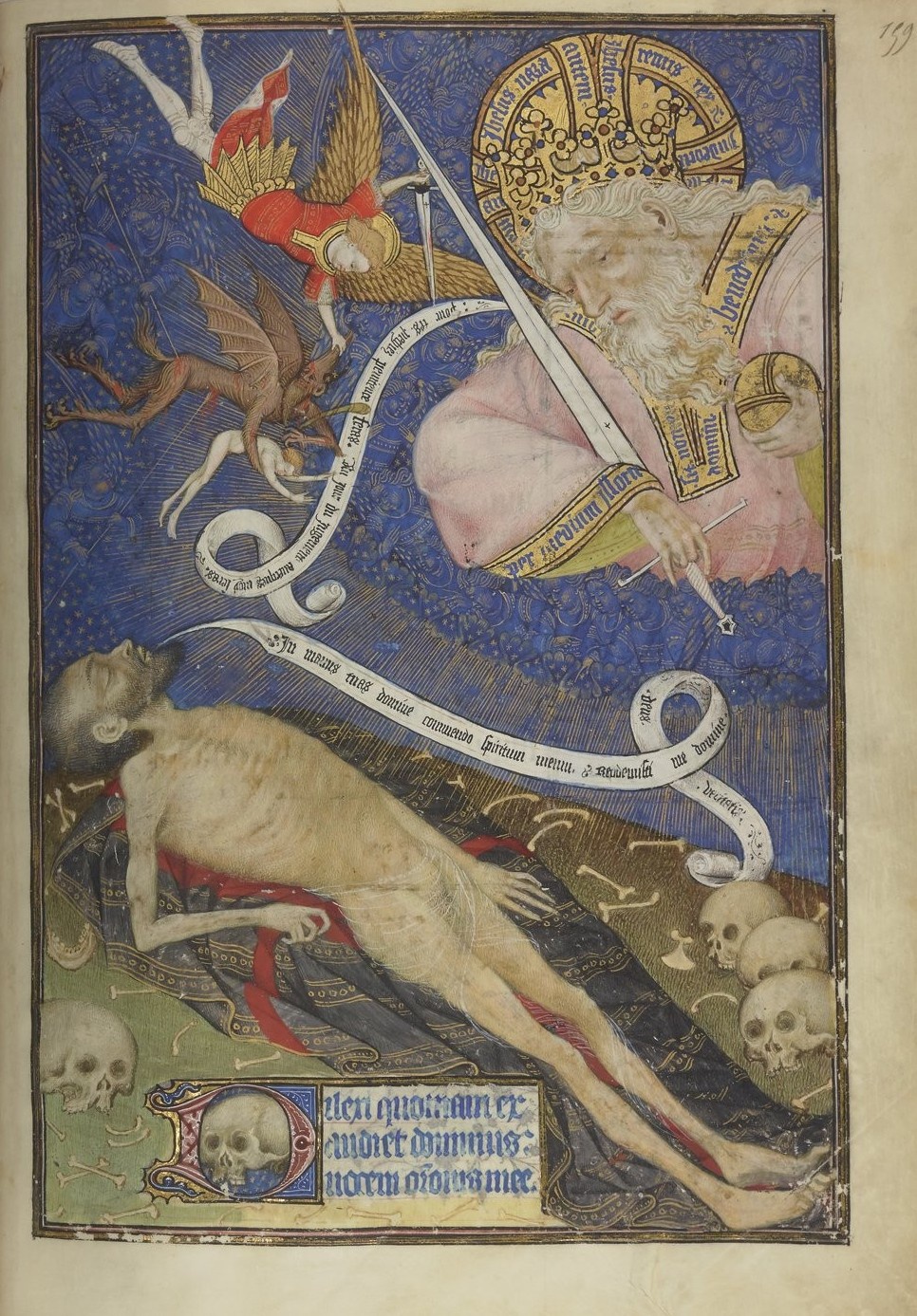
The Master of Rohan, Pietà. c. 1430. Grandes Heures de Rohan. Paris, Bibliothèque nationale de France, ms. lat. 9471.
The influence of the Master of Rohan on his contemporaries is important: many illuminated manuscripts show stylistic similarities with the Master of Rohan's style, but the high quality and the unique expressiveness remain unmatched. Several attempts were made to isolate different hands working alongside the Master of Rohan in his manuscripts, none of which are truly convincing. Given the spread of the master's style, we therefore tend to consider that the Master of Rohan might have been at the head of a small workshop. Manuscripts specialist Inès Villela-Petit proposed to isolate one illuminator, named by her the Master of Giac (after the Book of Hours made for a woman of the Giac family, now housed in Toronto, Royal Ontario Museum, ms. 997.158.14). She states that the Master of Giac could be the predecessor or the master of the Master of Rohan, but strangely, the Master of Giac is active in the same cities and at the same time as the Master of Rohan. The Master of Giac's name is sometimes used for some of the lower quality illuminations in manuscripts in collaboration with the Master of Rohan himself or for manuscripts stylistically close to the Master but less precious. If that's the case, it would be more logical to imagine that the Master of Giac was trained by the Master of Rohan, not the other way around.
We thank Peter Kidd, Christian Etheridge, and Natale Roman for their help regarding the provenance research.
Commentary
Scholars' studies have helped to understand the career of this true "eccentric Frenchman with a personal vision", to quote Sandra Hindman. The Master of Rohan was surely first active in Troyes, likely his hometown, at the dawn of the 15th century. From this period dates for example the Book of Hours for the use of Troyes now in Chantilly (Bibliothèque du château, ms. 67) or the Book of Hours (use of Troyes) now in Paris (Bibliothèque de l'Arsenal, ms. 647). The Master of Rohan then worked in Paris, collaborating with leading illuminators from 1415-1420 onwards. For instance, he collaborated with the Master of Bedford and the Master of the Cité des Dames on an exemplar of the De Casibus by Boccaccio (translation of Laurent de Premierfait), now in Paris (Bibliothèque nationale de France, ms. fr. 226). From c. 1425 to c. 1440, the Master of Rohan worked for the House of Anjou, illuminating some of his most beautiful manuscripts for them, such as the Hours of René d'Anjou (Paris, Bibliothèque nationale de France, ms. latin 1156A), or the Hours of Isabelle Stuart (Cambridge, the Fitzwilliam Museum, ms. 62). It was either at the end of his Parisian period, around 1420, or at the beginning of his establishment in Angers, around 1425, that the Master of Rohan and his workshop painted the two folios we present here, whose history is particularly fascinating.
The present two illuminated leaves depict 1. the Patroness in Prayer before the Virgin and Child and 2. the Flight into Egypt. These leaves come from a well-known and very interesting Book of Hours, commonly called the "ex-Boerner manuscript" in reference to the auctions sale held by the dealer C. G. Boerner, in Leipzig in 1912 and 1913 (see Provenance, below), in which the Book of Hours was presented (see for instance: S. Hindman, Medieval and Renaissance miniature paintings, Akron, Bruce Ferrini Rare Books & London, Sam Fogg Rare Books & Manuscripts, 1988, p. 49, 122). However, the name "ex-Boerner manuscript", which was very generic, was recently replaced by the "Heures dites Thouroude" (i. e., the so-called Thouroude Hours) by specialist Nathalie Roman (see her article: "Paul Durrieu (1855-1925): art collecting and scholarly expertise", in: The Pre-Modern Manuscript Trade and its Consequences, ca. 1890-1945, ed. L. Cleaver, D., Magnusson, H. Morcos & A. Rais, Arc Humanities Press, 2024). The so-called Thouroude Hours is obviously much more fitting, as it refers to the Thouroude (or Thouroulde, Théroulde) family, originally from Rouen, who owned the Book of Hours as early as the 15th or 16th century. The 1913 auction catalogue, which is much more detailed that the 1912 catalogue, indicated that numerous handwritten inscriptions, the oldest apparently datable to the 15th century, list the names of members of the Thouroude family, the last of whom died in 1812.
It is therefore very much possible that the Book of Hours was commissioned by the Thouroude family, and more precisely by the very woman of this family who is depicted in prayer before the Virgin and Child on one of the two present illuminated leaves. Not much is known about the Thouroude family, but some members are documented and seem to have had an enjoyable reputation, such as Guillaume de Thouroude, advisor to the King (documented in Rouen in the 16th century). It is also very interesting to mention that Jacquet Thouroulde is documented in Rouen in the second half of the 15th century, as a sculptor active in the construction site of the Cathedral of Rouen, where many other important artistes where working, such as Georges Trubert's brother Pierre Trubert. Since some of the members of the Thouroulde family are also documented in Paris, it is possible that they heard of the Master of Rohan's workshop in the capital.
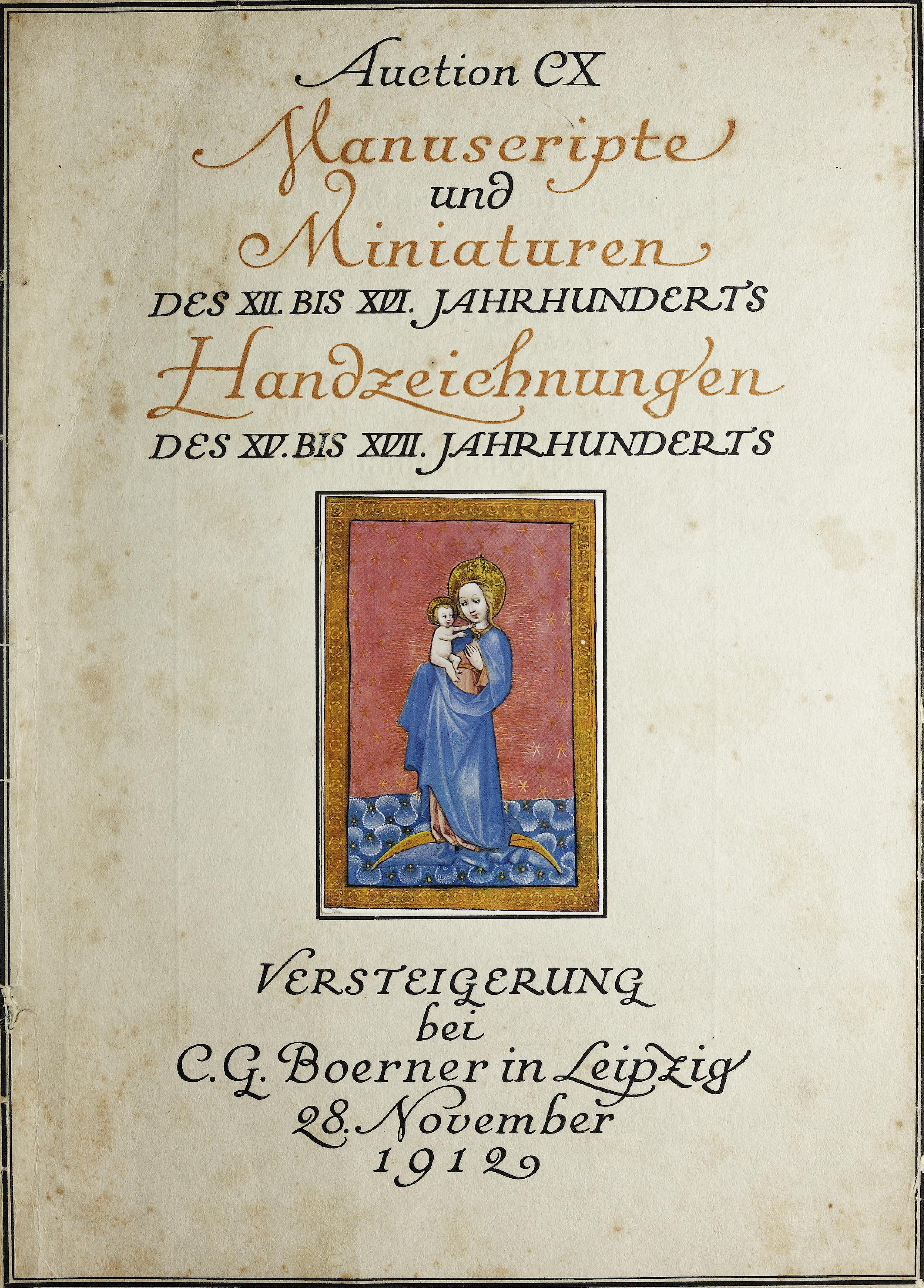
Auction catalogue, Leipzig, C. G. Boerner, November 28, 1912.
According to the 1913 auction catalogue, the Book of Hours remained in the hands of the Thouroude family until the early 19th century (the most recent inscription dated 1812). It is unknown how the manuscript ended up, one hundred years later, in the 1912 sale of the dealer C. G. Boerner in Leipzig. However, from that date until today, the provenance of the Book of Hours and its detached folios are well-documented. We know that the manuscript was dismembered in France between 1925, the date of its last appearance in its original state (Paris, Me Henri Baudoin auctioneer, November 30, 1925, lot 71), and 1937, when seventeen of the eighteen illuminated leaves from the collection of Georges Aubry (painter, art dealer and collection; 1885-1968) that adorned the Book of Hours were offered on the Parisian auction market (Paris, Hôtel Drouot, February 22, 1937, lots 36 to 52; see Provenance and Sister leaves, below). A few leaves must have been unsold, as they appear two years later at auction, also from the collection of Georges Aubry (Paris, Hôtel Drouot, February 13, 1939, lots 25 to 28: King David, Presentation to the Temple, Saint Marc, and Saint Matthew). These four lots were subsequently in the collection of Florence Goud, in New York, and later sold together in 1985 (New York, Sotheby's, April 25, lot 90). Thanks to the 1913 auction catalogue, we know all the miniatures that were part of the Thouroude Hours, but today, only a few pages are located. Amongst them, it is worth mentioning the beautiful miniature of the Visitation, which is now in the Museum of Fine Arts in Stockholm.
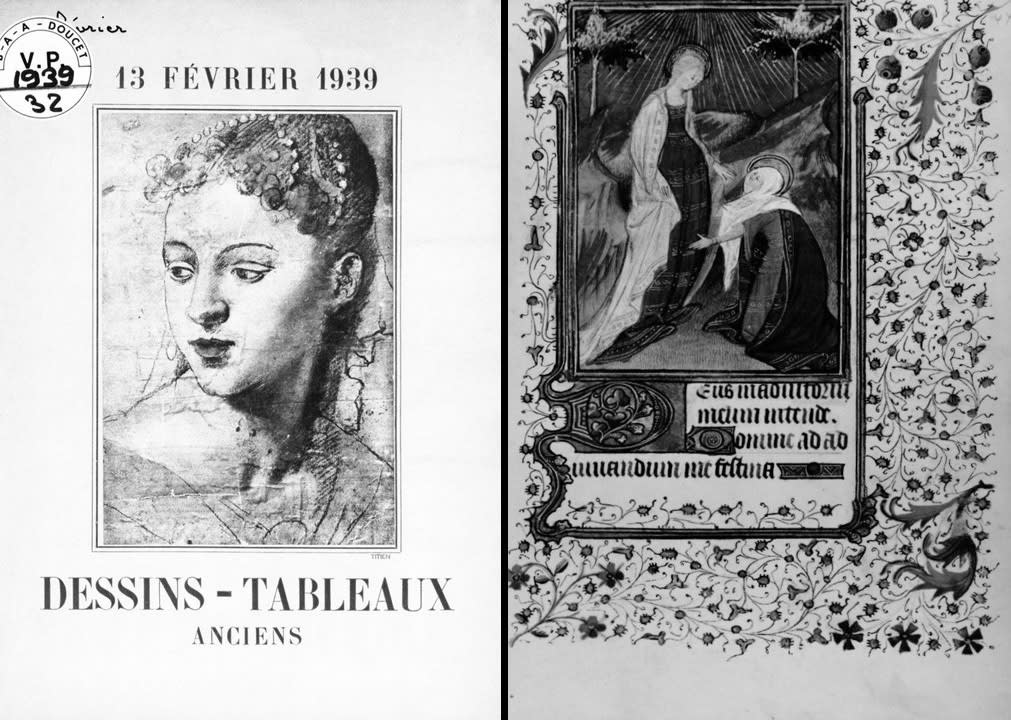
Left: auction catalogue, Paris, Hôtel Drouot, Me Beller, February 22, 1937 | Right: The Master of Rohan (and workshop), The Visitation, c. 1420-1425. Thouroude Hours. Stockholm, nationalmuseum, NMB 1906.
It is interesting to mention that as early as 1913, the miniatures of the Book of Hours were compared to the illuminations in the Grandes Heures de Rohan (even if it was, at this time, sold as a manuscript realized in Brittany, most certainly because of the origine of the Thouroude family). In the 19125 and 1937 auctions catalogues, the experts mentioned stylistic similarities with Lescuier d'Angers, a hypothetical identification for the Master of Rohan that was proposed by Paul Durrieu in 1912, but that is now abandoned. As early as the 1930s, the Book of Hours from which these two folios originate attracted the interest of art historians, who have frequently mentioned it in articles or books, attributing it to the Master of Rohan himself or his workshop: for Adelheid Heinmann, Carl Nordenfalk or Natalie Roman, the so-called Thouroude Hours are painted by the workshop of the Rohan Master, while Jean Porcher, Millard Meiss and Sandra Hindman attribute the miniatures of the Book of Hours to the Master of Rohan himself (see Published in, below).
From a stylistic point of view, these two illuminations feature strikingly expressive brushwork and ingenious staging. The paintings of the Patroness in Prayer before the Virgin and Child and the Flight into Egypt are particularly similar to the paintings of a Book of Hours produced around the same time and now attributed to the Master of Rohan and his workshop : the so-called De Buz Hours, named so in reference of its 16th century former owner, Antoine de Buz, now held in the Houghton Library (Harvard University, ms. Richardson 42). A comparison of these two illuminations with the paintings in that book shows the same expressive, rapid brushwork, almost appearing scratched, as well as the same preference for elongated, sometimes disproportionate figures. In the Flight into Egypt, the motif of the angel guiding Saint Joseph and the Virgin stands out, while in the other illumination, the valuable image of the portrait of the manuscript's original patroness, most certainly a woman from the Thouroude family, depicted kneeling and in prayer before the Virgin and Child, is highly precious and serve as an witness of the network of patrons of the Master of Rohan's workshop.
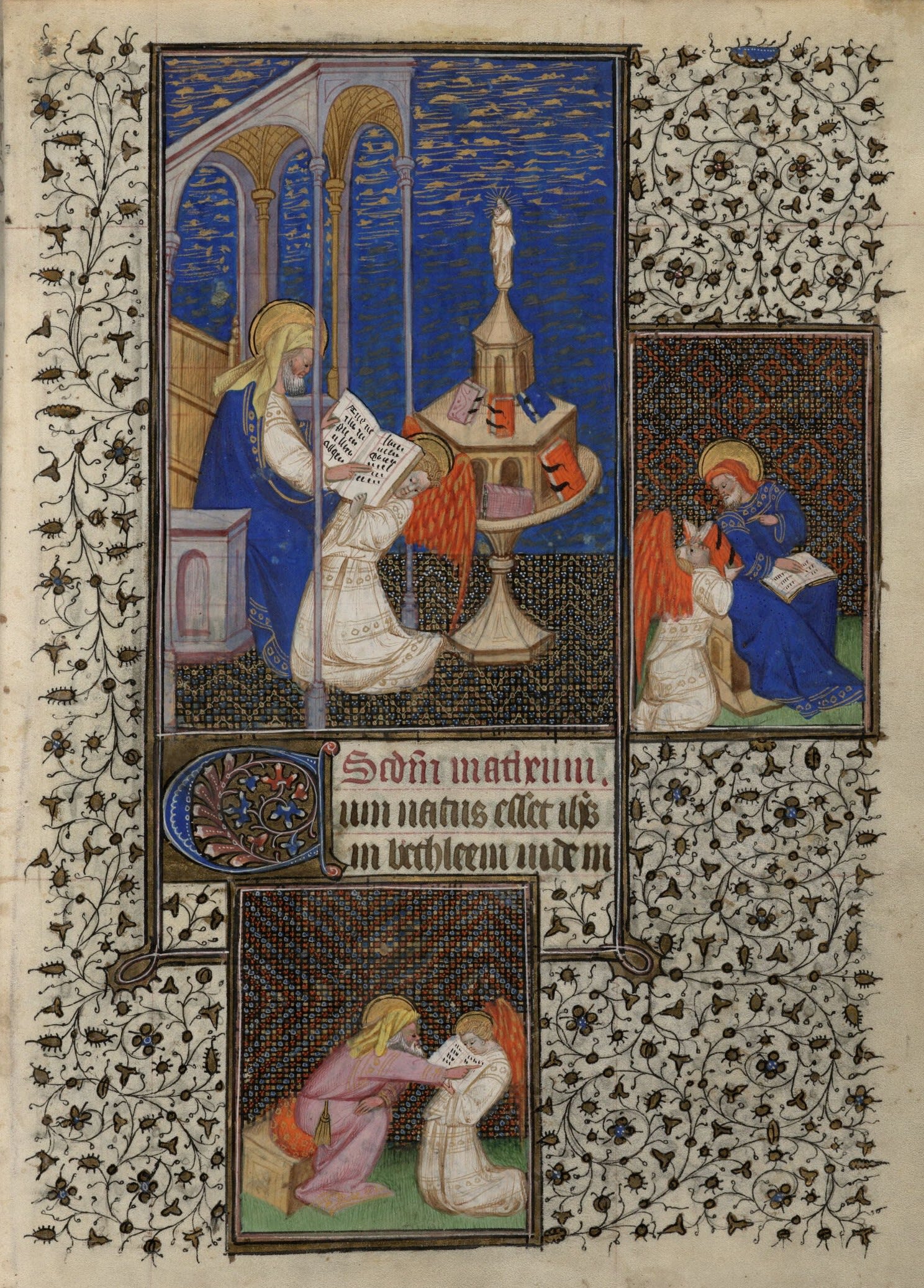
The Master of Rohan (and workshop), Saint Matthew, c. 1420-1425. De Buz Hours. Harvard University, Houghton Library, ms. Richardson 42.
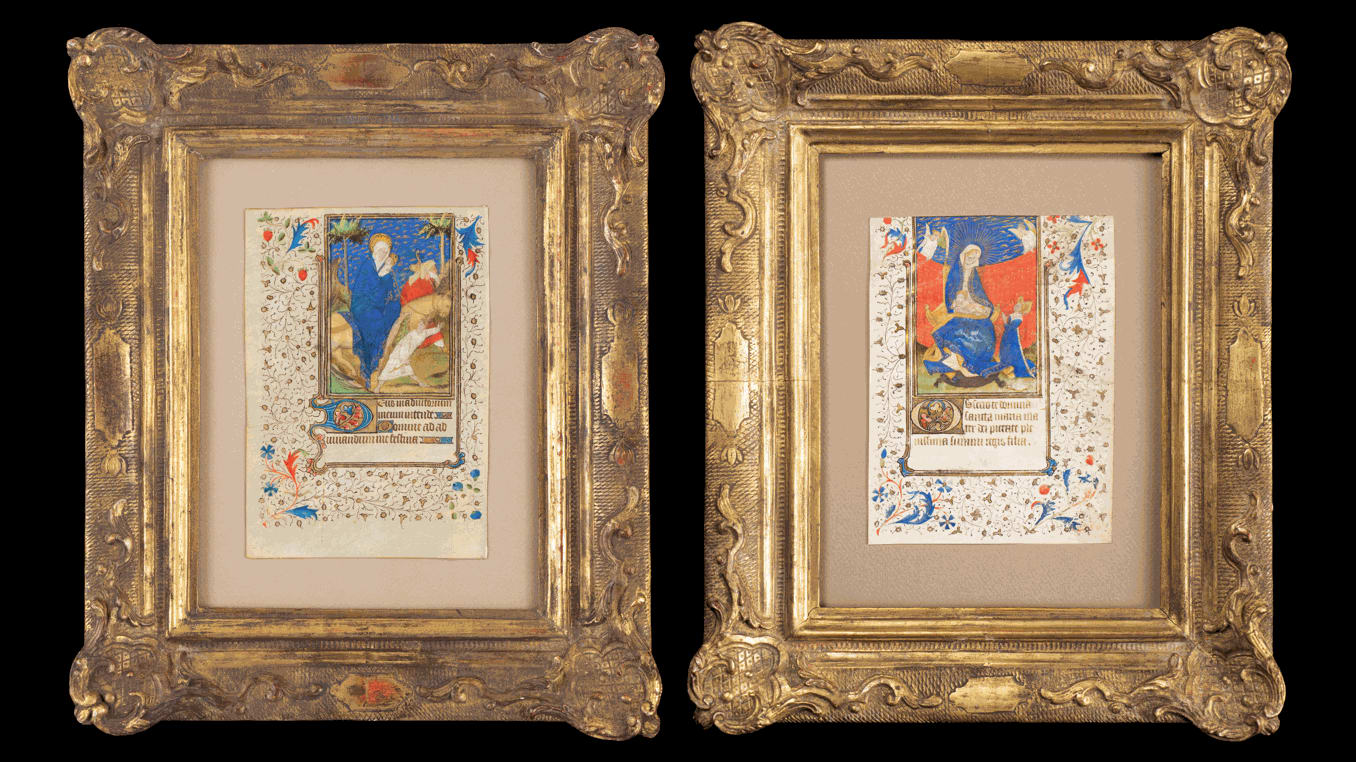
The Master of Rohan (and workshop), Two illuminated leaves from the so-called Thouroude Hours, c. 1420-1425.
Material description
Two illuminated leaves on vellum, from a Book of Hours, in Latin.
Gothic Bastarda, in brown and red ink; one column, ruled for 15 lines.
Paintings: two large illuminations (1. Patroness in prayer before the Virgin and Child; 2. Flight into Egypt); two 3-line decorated initials ('O' on the Patroness in prayer before the Virgin and Child; 'D' on the Flight into Egypt); illuminated borders on three sides of both leaves (black rinceaux with gilded ivy leaves, red and blue acanthus leaves, floral ornaments). On the verso of the Patroness in prayer before the Virgin and Child: fifteen lines of text. On the verso (originally the recto) of the Flight into Egypt: two 2-lines decorated initials ('S'; 'O'); two 1-line decorated initials ('B'; 'D'); illuminated borders on all four sides.
Text: 1. Patroness in prayer before the Virgin and Child, beginning of the Obsecro Te: "Obsecro te [...] regis filia" (recto); "Mater gloriosissima [...] divinum mysterium" (verso); 2. Flight into Egypt, excerpt from the Hours of the Virgin: "Spiritus paraditus [...] Ad vesperas" (verso, originally the recto); "Deus in adiutorium [...] me festina" (recto, originally the verso).
The parchment is somewhat worn and warped (especially in the Flight into Egypt); some signs of rubbing and some paint losses (notably on the Patroness in prayer before the Virgin and Child or on the Virgin's drapery on the Flight into Egypt); some signs of aging (slight ink stains or slight fading of certain marginal decorations, particularly in the lower right of the Patroness in prayer before the Virgin and Child). Two modern inscriptions: "18" (graphite, the top right of the Patroness in prayer before the Virgin and Child, recto) and "80" (graphite, the top right of the Flight into Egypt, verso-originally the recto) indicating the former foliation. The colors have remained vivid, and the expressiveness of the brushwork is visible. The two illuminations are individually housed in wooden frames (34.5 x 29 cm) with gilded ornamentation, with anti-UV and anti-reflective plexiglasses.
Provenance
The two present illuminated leaves were part of the so-called Thouroude Hours, illuminated in Paris or Angers (France) c, 1420-1425 by the Master of Rohan (and workshop), most certainly for the Thouroude family, of Rouen, and more precisely for the woman depicted on the illuminated leaf depicting the Patroness in prayer before the Virgin and Child. This leaf was fol. 18, while the Flight into Egypt was fol. 80v.
The Book of Hours, complete, was owned by the Thouroude family, of Rouen, from the 15th or 16th century until the 18th or 19th century, according to handwritten inscriptions on the last folios of the Book of Hours that were seen in the early 20th century when the manuscript was sold in Leipzig.
Leipzig, C. G. Boerner, November 28, 1912, lot 7 (as "Französisch. 2. Hälfte des 15. Jahrhundert"; most certainly unsold).
Leipzig, C. G. Boerner, Katalog XXV [1913], lot 9 (as "nordwesttranzösischen Ursprungs (Bretagne?), ca. 1440; Werkstatt des Maître des Grandes Heures de Rohan").
France, private collection of an amateur.
Paris, his sale, Hôtel Drouot, Me Henri Baudoin, November 30, 1925, lot 71 (as "Ouest de la France", and with similarities to the art of Lescuier d'Angers).
Paris, collection Georges Aubry (1885-1968), artist, collector and art dealer.
Paris, his sale, Hôtel Drouot, Me Alphonse Bellier, February 22, 1937, lots 36 to 52 (as "Ouest de la France, and with similarities to the art of Lescuier d'Angers). The Flight into Egypt was lot 37, and the Patroness in prayer before the Virgin and Child was lot 52). The provenance of the two illuminated leaves at hand is as follows:
Patroness in prayer before the Virgin and Child:
England, collection art historians Alfred (1900-1965) and Felicie (1901-1991) Scharf.
London, Christie's, July 12, 2023, lot 11 (as "workshop of the Rohan Master").
Switzerland, private collection.
Flight into Egypt:
France, private collection.
Paris, Oger-Blanchet, October 27, 2022, lot 376 (as "Nord de la France, vers 1450 ?").
Switzerland, private collection.
Sister leaves
Ex-fol. 21: Virgin with the Child: current location unknown.
Ex-fol. 26: Saint John: Paris, collection Georges Aubry; Paris, Hôtel Drouot, February 22, 1937, lot 46; current location unknown.
Ex-fol. 28: Saint Matthew: Paris, collection Georges Aubry; Paris, Hôtel Drouot, February 22, 1937, lot 48; Paris, Hôtel Drouot, February 13, 1939, lot 28; New York, collection Florence Gould; New York, Sotheby's, April 25, 1985, part of lot 90; private collection (in 1988).
Ex-fol. 29: Saint Luke: Paris, collection Georges Aubry; Paris, Hôtel Drouot, February 22, 1937, lot 47; current location unknown.
Ex-fol. 31: Saint Marc: Paris, collection Georges Aubry; Paris, Hôtel Drouot, February 22, 1937, lot 45; Paris, Hôtel Drouot, February 13, 1939, lot 27; New York, collection Florence Gould; New York, Sotheby's, April 25, 1985, part of lot 90; private collection (in 1988).
Ex-fol. 33: Annunciation: Paris, collection Georges Aubry; Paris, Hôtel Drouot, February 22, 1937, lot 37; current location unknown.
Ex-fol. 44: Visitation: Paris, collection Georges Aubry; Paris, Hôtel Drouot, February 22, 1937, lot 43; Paris, collection Georges Ryaux; Stockholm, Nationalmuseum, NMB 1906 (bought in 1964).
Ex-fol. 55: Crucifixion: Paris, collection Georges Aubry; Paris, Hôtel Drouot, February 22, 1937, lot 44; Paris, Hôtel Drouot, June 20, 1939, lot 24; Akron, Bruce Ferrini & London, Sam Fogg (in 1988).
Ex-fol. 56v: Pentecost: Paris, collection Georges Aubry; Paris, Hôtel Drouot, February 22, 1937, lot 49; current location unknown.
Ex-fol. 57v: Nativity: Paris, collection Georges Aubry; Paris, Hôtel Drouot, February 22, 1937, lot 40; current location unknown.
Ex-fol. 63v: Annunciation to the Shepherd: Paris, collection Georges Aubry; Paris, Hôtel Drouot, February 22, 1937, lot 39; current location unknown.
Ex-fol. 69v: Adoration of the Magi: Paris, collection Georges Aubry; Paris, Hôtel Drouot, February 22, 1937, lot 41; current location unknown.
Ex-fol. 75: Presentation to the Temple: Paris, collection Georges Aubry; Paris, Hôtel Drouot, February 22, 1937, lot 42; Paris, Hôtel Drouot, February 13, 1939, lot 26; New York, collection Florence Gould; New York, Sotheby's, April 25, 1985, part of lot 90; private collection (in 1988).
Ex-fol. 88v: Coronation of the Virgin: Paris, collection Georges Aubry; Paris, Hôtel Drouot, February 22, 1937, lot 50; current location unknown.
Ex-fol. 95: King David: Paris, collection Georges Aubry; Paris, Hôtel Drouot, February 22, 1937, lot 36; Paris, Hôtel Drouot, February 13, 1939, lot 25; New York, collection Florence Gould; New York, Sotheby's, April 25, 1985, part of lot 90; private collection (in 1988).
Ex-fol. 113: Death chasing a man: Paris, collection Georges Aubry; Paris, Hôtel Drouot, February 22, 1937, lot 51; current location unknown.
Published in (citing the present leaves and/or the Thouroude Hours' leaves)
C. G. Boerner, Manuscripte und Miniaturen des XII. bis XVI. Jahrhunderts, Handzeichnungen des XV. bis XVII. Jahrhunderts, Leipzig, 1912, n° 7, p. 6-7 [as French, second half of the 15th century].
C. G. Boerner, Gothische Miniaturmalerei, Katalog XXV, Leipzig, [1913], n° 9, p. 15-17 [as North-West France, Brittany (?) c. 1440, workshop of the Master of Rohan].
A. Heimann, "Der Meister der 'Grandes Heures de Rohan' und seine Werkstatt", Städel-Jahrbuch, 1932, p. 12, n. 24 [as workshop of the Master of Rohan].
J. Porcher, The Rohan Book of Hours, New York, 1959, p. 32, n. 11 [as Master of Rohan].
M. Meiss, French painting in the time of Jean de Berry. The Limbourgs and their contemporaries, New York, 1974, I, p. 404 [as Master of Rohan].
C. Nordenfalk, Bokmålningar från medeltid och renässans i Nationalmusei samlingar: en konstbok från Nationalmuseum, Stockholm, 1979, p. 102 [as workshop of the Master of Rohan].
Gyllene böcker: nyförvärv och nyupptäckter, exhibition catalogue (Stockholm, Nationalmuseum, December 13, 1987-March 6, 1988), ed. U. Abel & N. G. Hökby, Stockholm, 1987, n°50, p. 50 [as workshop of the Master of Rohan].
S. Hindman, Cloister, city and court miniature painting in the later Middle Ages and the Renaissance, Tokyo, Maruzen Co. Ltd., 1988, n° 25 [as Master of Rohan].
S. Hindman, Medieval and Renaissance miniature paintings, Akron, Bruce Ferrini Rare Books & London, Sam Fogg Rare Books & Manuscripts, 1988, p. 49, 122 [as Master of Rohan].
R. C. Simons, "Rohan workshop Book of Hours: reassessing the models", Gazette des Beaux-Arts, 2002 (140), p. 69-72 [as workshop of the Master of Rohan].
N. Roman, "Paul Durrieu (1855-1925): art collecting and scholarly expertise", in: The Pre-Modern Manuscript Trade and its Consequences, ca. 1890-1945, ed. L. Cleaver, D. Magnusson, H. Morcos & A. Rais, Arc Humanities Press, 2024, p. 318-319 [as workshop of the Master of Rohan].
Further reading on the Master of Rohan and his workshop
P. Durrieu, "Le maître des 'Grandes Heures de Rohan' et les Lescuier d'Angers", Revue de l'art ancien et moderne, 1912 (32).
E. Panofsky, "Reintegration of a Book of Hours Executed in the Workshop of the 'Maître des Heures de Rohan'", in: Mediaeval Studies in Memory of Arthur Kingsley Porter, ed. W. R. W. Koehler, Cambridge, 1939, II.
G. Ring, A Century of French Painting 1400-1500, London, 1940.
É. Mâle, Les Grandes Heures de Rohan, Paris, 1947.
E. Panofsky, Early Netherlandish Painting: Its Origins and Character, Cambridge, 1953.
J. Porcher, "Le Maître de Rohan. Un grand peintre français du XVe siècle", Le Jardin des arts, 1956 (15).
L. M. J. Delaissé, A Century of Dutch Manuscript Illumination, Los Angeles, 1968.
M. Meiss & M. Thomas, The Rohan Master: A Book of Hours, London & New York, 1973.
F. Avril, "La peinture française au temps de Jean de Berry", Revue de l'art, 1975 (28).
F. Avril & N. Reynaud, Les manuscrits à peintures en France, 1440-1520, Paris, 1993.
Les Très Riches Heures du duc de Berry et l'enluminure en France au début du XVe siècle, exhibition catalogue (Chantilly, Musée Condé, March 31-August 2, 2004), dir. P. Stirnemann & I. Villela-Petit, Paris, 2004.
E. König, Die Grandes Heures de Rohan, Simbach am Inn, 2006.
I. Villela-Petit, "Les Heures de Jeanne du Peschin, dame de Giac. Aux origines du Maître de Rohan", Art de l'enluminure, 2010 (34).
S. Panayotova, "The Rohan Masters: collaboration and Experimentation in the Hours of Isabella Stuart", in: Manuscripta Illuminata: Approaches to Understanding Medieval and Renaissance Manuscripts, ed. C. Hourihane, Princeton, 2014.
S. Brouquet, "Le Maître de Rohan, un artiste engagé?", in: De Dante à Rubens: l'artiste engagé, dir. É. Anheim & P. Boucheron, Paris, 2020.